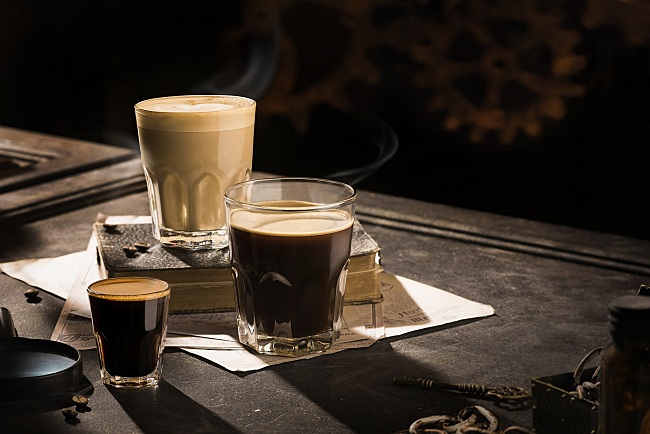The Growing Trend of Choosing SOE Single Origin Espresso at Home
Wiki Article
Discovering the Rich Flavors of Coffee Beans: a Deep Dive Into Coffee and Blended Coffee Beans
When you check out the abundant tastes of coffee beans, you discover a complex globe where each variety brings its own character to your mug. As you navigate through the art of coffee and the creative thinking behind combined coffees, you'll begin to appreciate the nuances that make each sip distinct.The Beginnings of Coffee Beans: Exploring Terroir and Flavor Profiles
When you take a sip of coffee, you're not simply enjoying a beverage; you're experiencing an abundant tapestry of tastes formed by the beans' origins. Each area generates special taste profiles influenced by environment, dirt, and altitude. Beans from Ethiopia frequently rupture with intense, fruity notes, while those from Colombia often tend to offer a well balanced, nutty sweet taste.As you check out various origins, you'll discover how terroir-- the ecological elements affecting a crop-- plays a crucial role - Single Origin Espresso. The very same coffee range can taste substantially different relying on where it's grown
When you take into consideration these factors, you begin to appreciate the intricacy behind your mug. Each sip narrates of the land and the farmers that nurtured the beans. Next time you indulge, assume about the journey your coffee took before it reached your hands, and savor those intricate tastes that reflect its beginning.
Understanding Coffee: The Art and Scientific Research Behind the Mixture
When you think of espresso, it's not nearly the solid flavor; it's also concerning the methods that bring it to life. Recognizing how various prep work techniques influence taste can transform your brewing experience. Allow's explore the complexities of espresso prep work and reveal the one-of-a-kind taste profiles that make each mug unique.Coffee Prep Work Techniques
Espresso preparation is both an art and a scientific research, incorporating exact techniques with a deep understanding of coffee. To begin, you'll desire to select premium, fresh roasted beans and grind them carefully for excellent extraction (Single Origin Espresso). The grind size is crucial; also coarse, and your coffee will be weak, also great, and it'll be bitterNext, tamp the premises uniformly in the portafilter to guarantee consistent removal. When you secure it right into the device, aim for a developing temperature between 190 ° F and 205 ° F.As you draw the shot, watch for the perfect extraction time-- around 25-30 secs. The outcome must be an abundant, luscious espresso with an attractive layer of crema on top. With practice, you'll grasp these methods.
Taste Accounts Described
The globe of espresso provides an abundant tapestry of taste accounts that can elevate your coffee experience. You'll observe an equilibrium of sweetness, resentment, and level of acidity when you take that first sip. Each espresso bean lugs unique notes, from floral and fruity to nutty and chocolaty. Light roasts commonly showcase bright acidity and vibrant flavors, while dark roasts present much deeper, bolder tones.A well-crafted blend might harmonize the brilliant notes of an Ethiopian bean with the abundant, chocolatey touches of a Brazilian bean. Accept the trip of uncovering coffee's diverse tastes, and you'll change your coffee ritual right into an exciting journey.
Handling Techniques: Exactly How They Impact Taste and Fragrance
While it could appear that the origin of coffee beans is one of the most substantial consider establishing their taste and scent, the processing methods used post-harvest play an equally crucial role. You'll find that these methods can dramatically modify the final preference profile of your cup.For instance, the washed process removes the fruit from the beans prior to fermentation, typically bring about a cleaner, brighter flavor. The natural process leaves the fruit undamaged during drying out, resulting in a sweeter, fruitier profile.
Various other approaches, like honey handling, strike a balance, enabling some fruit mucilage to continue to be, supplying a special intricacy.
Each processing method engages with the beans' integral features, enhancing or muting particular flavors and fragrances. So, when you drink that espresso or mixed coffee, bear in mind that the trip from cherry to cup is affected not simply by beginning however additionally by just how those beans were refined.
Toasting Strategies: Opening the Full Potential of Coffee Beans
Roasting methods are crucial for exposing the complete potential of coffee beans, as they change raw, eco-friendly beans into the aromatic, tasty coffee you delight in. The choice of toasting method-- light, medium, or dark-- dramatically affects flavor profiles.You can trying out toasting times and temperatures to find your perfect mixture. A slower roast at lower temperatures allows for intricate flavors to develop, while a quicker roast can increase resentment. Focus on the splits throughout roasting; the initial crack indicates a light roast, while the 2nd crack signals a dark roast. By mastering these methods, you'll expose a world of taste, elevating your coffee experience to new elevations. Take SOE pleasure in every sip, knowing the treatment that entered into your cup!
The Magic of Blended Coffee: Developing Unique Flavor Experiences
Creating a special flavor experience with blended coffee can change your morning routine into an expedition of taste. By incorporating various beans from various areas, you can expose a symphony of tastes that raise your cup to new elevations. Each blend offers an unique account, stabilizing sweetness, level of acidity, and body to create something absolutely special.When you choose a mix, you're not just selecting a coffee; you're picking a trip across varied landscapes and cultures. Trying out various combinations allows you to find your personal faves, whether you enjoy fruity notes or rich, chocolatey undertones.

Tasting Notes: Recognizing the Subtleties in Your Mug
As you drink your coffee, you might observe a range of tastes dancing on your palate, each revealing the intricacies of the beans. You may taste the intense acidity reminiscent of citrus or the deep, rich notes comparable to dark chocolate. The sweet taste can evoke honey or caramel, balancing the overall profile beautifully.Pay interest to the body of the coffee-- does it feel light and airy, or is it full and creamy? The surface, as well, uses hints; a lingering aftertaste may hint at nuttiness or flower undertones.

Don't forget to check out the special characteristics of different origins, as each area presents distinct tastes - Single Origin Espresso. Ethiopian coffees often present fruity notes, while Colombian beans might showcase an extra spherical sweet taste. By acknowledging these subtleties, you'll grow your appreciation for each and every cup, elevating your coffee experience to brand-new heights

Brewing Methods: Making Best Use Of Taste Extraction for every single Bean
When you explore the different brewing methods, you'll find that each strategy can significantly affect the taste profile of your coffee. From French press to pour-over, each approach removes different compounds, improving or silencing details notes. Using a French press allows oils to stay in the mixture, producing a richer taste, while pour-over stresses clarity and brightness.Temperature level and grind size likewise play important roles. A coarser grind functions best for cold brews, while a great grind is excellent for coffee. Try out water temperature level-- between 195 ° F and 205 ° F-- can disclose covert flavors, too.
Do not forget soaking time; a quick extraction can lead to sour notes, while over-extraction might yield anger. By changing these variables, you can optimize flavor extraction and genuinely raise your coffee experience. Take pleasure in the journey of uncovering what approach ideal matches your palate!
Regularly Asked Inquiries
What Is the Suitable Water Temperature Level for Developing Coffee?
The suitable water temperature for brewing coffee's in between 195 ° F and 205 ° F. If you utilize water that's too hot, you'll over-extract flavors; also cold, and you will not remove sufficient. Purpose for that wonderful place for the ideal brew!How Does Grind Size Affect Coffee Flavor?
Work dimension significantly affects coffee taste. Finer grinds remove much more tastes and oils, causing a bolder taste, while coarser grinds return a lighter taste. Readjusting work dimension aids you achieve your desired coffee account.Are There Health Perks Related To Drinking Coffee?

What Is the Difference In Between Arabica and Robusta Beans?
Arabica beans are smoother and sweeter, typically featuring fruity tastes, while robusta beans are stronger with a bitter taste and higher high levels of caffeine material. You'll notice these distinctions in scent and developing experience.How Can I Store Coffee Beans for Freshness?
To keep coffee beans for freshness, keep them in an airtight container, away from wetness, light, and warmth. If you only grind what you require right prior to brewing., you'll keep their flavor longer.Checking Out the Rich Flavors of Coffee Beans: a Deep Dive Into Espresso and Blended Coffee Beans.
When you explore the abundant flavors of coffee beans, you reveal a complicated world where each variety brings its own character to your mug.When you take a sip of coffee, you're not just appreciating a drink; you're experiencing a rich tapestry of tastes formed by the beans' origins.Roasting strategies are crucial for disclosing the full potential of coffee beans, as they change raw, environment-friendly beans right into the aromatic, tasty coffee you take pleasure in.As you drink your coffee, you might see a range of flavors dancing on your palate, each disclosing the complexities of the beans.
Report this wiki page